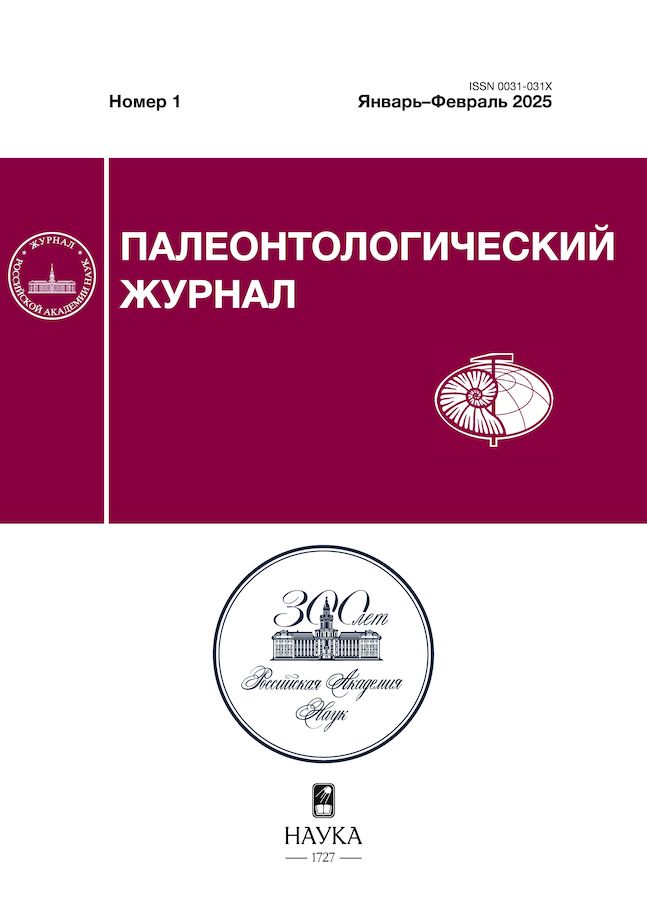To the revision of the middle Permian bolosaurids (Tetrapoda, Bolosaurida) of Eastern Europe
- Authors: Bulanov V.V.1,2
-
Affiliations:
- Borissiak Paleontological Institute, Russian Academy of Sciences
- Russia Kazan Federal University
- Issue: No 1 (2025)
- Pages: 78-91
- Section: Articles
- URL: https://cardiosomatics.ru/0031-031X/article/view/684096
- DOI: https://doi.org/10.31857/S0031031X25010098
- EDN: https://elibrary.ru/CQPWOY
- ID: 684096
Cite item
Abstract
A re-examination of the holotype of Permotriturus herrei Tatarinov, 1968 (Tetrapoda, Bolosaurida) supplemented by a new specimen from the type locality Isheevo, Republic of Tatarstan, European Russia, supports the validity of the genus Belebey Ivakhnenko, 1973. The differences between the genera Belebey and Permotriturus were established in the relationships of elements forming the suborbital portion of the skull roof, features of tooth implantation, as well as in the pattern of vasculature of the jaw bones. In spite the specialized condition of the dental system of P. herrei and its upper-most (terminal Urzhumian) stratigraphic position in comparison with other bolosaurid species, the morphology of its cheek region exhibits more similarity with that of the lower Permian bolosaurids of North America other than members of the genus Belebey. The absence of clear diagnostic criteria allows no possibility for subdivision of the order Bolosaurida on taxa of the family rank based on its middle Permian representatives.
Keywords
Full Text
About the authors
V. V. Bulanov
Borissiak Paleontological Institute, Russian Academy of Sciences; Russia Kazan Federal University
Author for correspondence.
Email: bulanov@paleo.ru
Russian Federation, Moscow, 117647; Kazan, 420008
References
- Буланов В.В. О находке диадектоморфных тетрапод в нижней перми Восточной Европы // Палеонтол. журн. 2023. № 2. С. 88–99.
- Буланов В.В. О таксономическом положении Davletkulia gigantea Ivachnenko // Палеонтол. журн. 2024. № 5.
- Ивахненко М.Ф. Новые котилозавры Приуралья // Палеонтол. журн. 1973. № 2. С. 131–134.
- Ивахненко М.Ф. Раннепермские элементы фаунистических комплексов тетрапод Восточной Европы // Палеонтол. журн. 1990. № 2. С. 102–111.
- Ивахненко М.Ф. Тетраподы Восточно-Европейского плакката – позднепалеозойского территориально-природного комплекса. Пермь: “Книга”, 2001. 200 с.
- Ивахненко М.Ф. Подкласс Captorhinomorpha // Ископаемые позвоночные России и сопредельных стран. Ископаемые рептилии и птицы. Часть 1 / Ред. М.Ф. Ивахненко, Е.Н. Курочкин. М.: ГЕОС, 2008. С. 86–94.
- Ивахненко М.Ф., Голубев В.К., Губин Ю.М. и др. Пермские и триасовые тетраподы Восточной Европы. М.: ГЕОС, 1997. 216 с. (Тр. Палеонтол. ин-та РАН. Т. 268).
- Ивахненко М.Ф., Твердохлебова Г.И. Ревизия пермских болозавроморфов Восточной Европы // Палеонтол. журн. 1987. № 2. С. 98–106.
- Татаринов Л.П. Находка примитивного хвостатого земноводного в верхней перми Поволжья // Верхнепалеозойские и мезозойские земноводные и пресмыкающиеся. М.: Наука, 1968. С. 7–10.
- Berman D.S., Reisz R.R., Scott D. et al. Early Permian bipedal reptile // Science. 2000. V. 290. P. 969–972.
- Berman D.S., Sumida S.S., Henrici A.C. et al. The Early Permian bolosaurid Eudibamus cursoris: earliest reptile to combine parasagittal stride and digitigrade posture during quadrupedal and bipedal locomotion // Front. Ecol. and Evol. 2021. V. 9. https://doi.org/10.3389/fevo.2021.674173
- Bulanov V.V., Kovalenko E.S., MacDougall M.J. et al. Tooth replacement and reparative dentine formation in the middle Permian bolosaurids of European Russia // Hist. Biol. 2022. V. 35. № 5. P. 748–761.
- Case E.C. Description of the skull of Bolosaurus striatus Cope // Bull. Amer. Mus. Natur. Hist. 1907. V. 23. P. 653–658.
- Cope E.D. Descriptions of the extinct Batrachia and Reptilia from the Permian formation of Texas // Proc. Amer. Phil. Soc. 1878. V. 17. № 101. P. 505–530.
- Falconnet J. First evidence of a bolosaurid parareptile in France (latest Carboniferous – earliest Permian of the Autun basin) and the spatiotemporal distribution of the Bolosauridae // Bull. Soc. Géol. France. 2012. V. 183. № 6. P. 495–508.
- Li J.L., Cheng Z.W. The first discovery of bolosaurs from Upper Permian of China // Vertebr. PalAsiat. 1995. V. 33. P. 17–23.
- Müller J., Li J.L., Reisz R.R. A new bolosaurid parareptile, Belebey chengi sp. nov., from the Middle Permian of China and its paleogeographic significance // Naturwiss. 2008. V. 95. № 12. P. 1174–1196.
- Reisz R.R., Barkas V., Scott D. A new Early Permian bolosaurid reptile from the Richards Spur Dolese Brothers Quarry, near Fort Sill, Oklahoma // J. Vertebr. Paleontol. 2002. V. 22. № 1. P. 23–28.
- Reisz R.R., Müller J., Tsuji L. et al. The cranial osteology of Belebey vegrandis (Parareptilia: Bolosauridae), from the Middle Permian of Russia, and its bearing on reptilian evolution // Zool. J. Linn. Soc. 2007. V. 151. P. 191–214.
- Snyder A.J., LeBlanc A.R.H., Jun C. et al. Thecodont tooth attachment and replacement in bolosaurid parareptiles // PeerJ. 2020. 8:e9168. https://doi.org/10.7717/peerj.9168
- Spindler F., Voigt S., Fisher J. Edaphosauridae (Synapsida, Eupelycosauria) from Europe and their relationship to North American representatives // Paläontol. Z. 2020. V. 94. № 1. P. 125–153.
- Watson D.M.S. On Bolosaurus, and the origin and classification of reptiles // Bull. Mus. Comp. Zool. 1954. V. 111. № 9. P. 297–449.
Supplementary files














